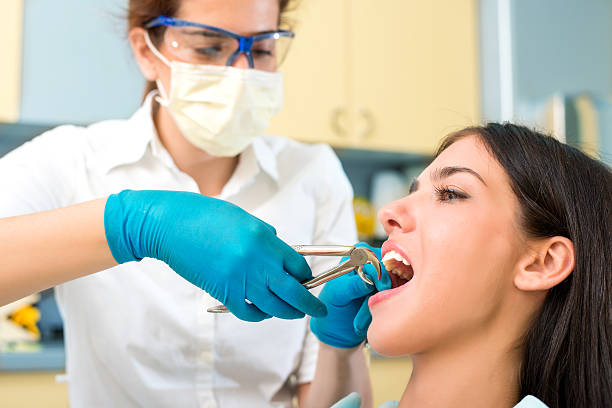
Dental Implant Complications
May 11, 2022
Cost of Removing all Teeth and Getting Dentures
May 11, 2022
may 11 • 4 MIN READ • MATTHEWS SMILES
Root Canal Alternatives
With the advancement in modern dentistry, you can now opt for other root canal alternatives. Besides, your dental well-being is a critical part of your overall health, so you don’t have to rely on only one dental treatment. If a root canal doesn’t seem like an appealing option for you, here are other treatments you can consider.
Tooth Extraction

Although tooth extraction may seem uncanny, it’s the best option if your tooth has extensive decay or is severely damaged. Some tooth extraction procedures are simple and easily carried out in a dentist’s office. Others are complex and may need an oral surgeon to break the damaged or hard-to-remove tooth into small pieces before extracting it.
After the tooth extraction, some of the ways to deal with the space can include:
• Dental bridges
• Dental implants
• Dental dentures
Direct Pulp Capping

Direct pulp capping is an oral treatment used when you have extensive decay or damage to your teeth that expose the pulp. If your healthy pulp is completely exposed, a dentist can recommend this procedure as an alternative to tooth removal or root canal.
Direct pulp capping involves drilling the cavity to eliminate any decayed material. A dentist also cleans the site and then adds a sedative material that prevents bacteria from reaching the pulp until the dentin repairs itself. Mineral Trioxide Aggregate or formocresol are some of the materials dentists use for this procedure. A filling is then placed on the tooth to strengthen it and allow you to bite and chew normally.
Note that a direct pulp cap is recommended when there is minimal exposure to the pulp. Dentists can also choose this solution if the exposed pulp shows no signs of decaying or inflammation. Also, the AAPD recommends that dentists should only use direct pulp capping on a primary tooth that is damaged due to mechanical trauma.
Indirect Pulp Capping

If the pulp tissue isn’t completely exposed and it’s close to the surface, indirect pulp capping can be a good alternative. Still, if you have a compromised tooth that doesn’t reveal the pulp, you can opt for indirect capping. You don’t have to undergo invasive procedures like tooth extraction. Better yet, this procedure allows the roots to continue developing.
An indirect pulp capping includes two treatments done in six to eight months. The first step involves removing the decaying tooth material without exposing the pulp tissue. A protective layer is then applied to promote tooth remineralization of the decayed dentin. Next, the dentist seals the tooth with a temporary filling. In the second appointment, the dentist evaluates the healing, and in most cases, they remove decayed residuals. The final step involves permanently filling the tooth.
Pulpotomy

Pulpotomy is also a great dental treatment for a decayed or infected tooth. Like direct pulp capping, this process involves the removal of the tooth’s pulp. A dental professional can opt for pulpotomy when your tooth’s pulp is overly compromised and exposed due to damage or decay. The main difference between pulpotomy and root canal treatment is that in the former, dentists preserve the tooth nerves and canals.
When performing a pulpotomy, dentists remove the inflamed or infected pulp. Inert material such as calcium hydroxide is then inserted into the affected tooth to prevent bacteria infection and facilitate faster healing. Lastly, a dentist places a crown on the tooth to restore it and prevent damage.
Pulpotomy is mainly performed on children with underdeveloped adult teeth or those that still have baby teeth. Still, a dentist can recommend this procedure in adults as an emergency to help relieve pain and eliminate the ache. Also, note that pulpotomy isn’t a viable solution in cases where the pulp has irreversible damage or any signs of infection.
Pulpectomy

Pulpectomy involves the removal of all the pulp tissue from the crown to the roots, also referred to as root canal surgery. Removing all contents in the inner part of the tooth’s chamber and cleaning the canals prevent further bacteria infection or necrosis to other teeth. This dental procedure is mainly performed on children with infected primary baby teeth.
Pulpectomy involves drilling a hole in the affected tooth to remove the pulp. A dentist also uses files to drill the nerve inside the pulp and eliminate all infected tissues. Next, the dentist irrigates the canal using a mixture of sodium hypochlorite and fills the pulp chamber with an inert material. A crown is then used to cap the tooth. This is a straightforward process with minimal chances of serious complications.
Endodontic Surgery

A dentist may recommend using endodontic surgery where a root canal treatment can’t save a tooth. Endodontic treatment can help find hidden canals or small fractures that aren’t detected on x-rays. This surgical alternative also offers an opportunity to treat damaged bone.
Apicoectomy is the most common surgical procedure. This procedure involves removing the damaged tissue, filling the area again, and resealing it. Apicoectomy helps to prevent infections and heal the bone around the roots naturally.
Conclusion

If you have a decayed tooth, one of the above treatment options can be a great alternative to a root canal. However, a root canal is still a crucial dental procedure that can guarantee the long-term health of your gums and teeth. Depending on your unique situation, a dentist can make the necessary evaluations and identify the most appropriate solution.
At Matthews Smiles Dentistry, we provide world-class dental care to every patient. Whichever dental issue you have, we can determine the most appropriate treatment alternative for your needs. Reach out to us today for the best possible dental and compassionate care.
Get In Touch

3610 N University Ave, Ste 200, Provo, UT 84604

(801) 377-9600

M-TH: 8-5, F: 8-4
With the advancement in modern dentistry, you can now opt for other root canal alternatives. Besides, your dental well-being is a critical part of your overall health, so you don’t have to rely on only one dental treatment.

